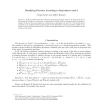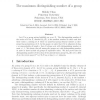134 search results - page 14 / 27 » Combinatorics of diagrams of permutations |
COMBINATORICS
2006
13 years 9 months ago
2006
In [5] the authors refine the well-known permutation statistic "descent" by fixing parity of one of the descent's numbers. In this paper, we generalize the results o...
COMBINATORICS
2007
13 years 9 months ago
2007
By introducing the notion of relative derangements of type B, also called signed relative derangements, which are defined in terms of signed permutations, we obtain a type B anal...
CPM
2004
Springer
14 years 3 months ago
2004
Springer
Abstract. This paper presents an elementary proof of the HannenhalliPevzner theorem on the reversal distance of two signed permutations. It uses a single PQ-tree to encode the vari...
COMBINATORICS
2006
13 years 9 months ago
2006
Let G be a group acting faithfully on a set X. The distinguishing number of the action of G on X, denoted DG(X), is the smallest number of colors such that there exists a coloring...
COMBINATORICS
2006
13 years 9 months ago
2006
In this paper, we study Grothendieck polynomials indexed by Grassmannian permutations from a combinatorial viewpoint. We introduce the factorial Grothendieck polynomials which are...


